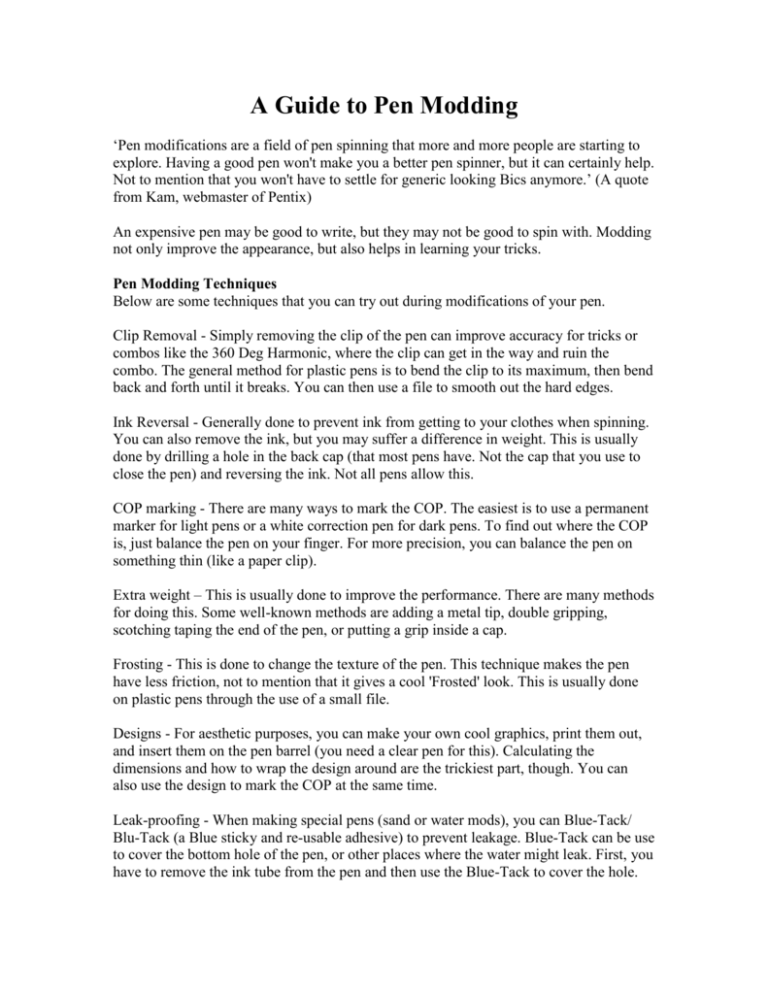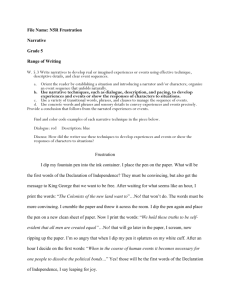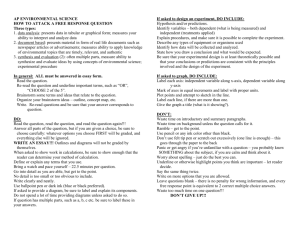
A Guide to Pen Modding
‘Pen modifications are a field of pen spinning that more and more people are starting to
explore. Having a good pen won't make you a better pen spinner, but it can certainly help.
Not to mention that you won't have to settle for generic looking Bics anymore.’ (A quote
from Kam, webmaster of Pentix)
An expensive pen may be good to write, but they may not be good to spin with. Modding
not only improve the appearance, but also helps in learning your tricks.
Pen Modding Techniques
Below are some techniques that you can try out during modifications of your pen.
Clip Removal - Simply removing the clip of the pen can improve accuracy for tricks or
combos like the 360 Deg Harmonic, where the clip can get in the way and ruin the
combo. The general method for plastic pens is to bend the clip to its maximum, then bend
back and forth until it breaks. You can then use a file to smooth out the hard edges.
Ink Reversal - Generally done to prevent ink from getting to your clothes when spinning.
You can also remove the ink, but you may suffer a difference in weight. This is usually
done by drilling a hole in the back cap (that most pens have. Not the cap that you use to
close the pen) and reversing the ink. Not all pens allow this.
COP marking - There are many ways to mark the COP. The easiest is to use a permanent
marker for light pens or a white correction pen for dark pens. To find out where the COP
is, just balance the pen on your finger. For more precision, you can balance the pen on
something thin (like a paper clip).
Extra weight – This is usually done to improve the performance. There are many methods
for doing this. Some well-known methods are adding a metal tip, double gripping,
scotching taping the end of the pen, or putting a grip inside a cap.
Frosting - This is done to change the texture of the pen. This technique makes the pen
have less friction, not to mention that it gives a cool 'Frosted' look. This is usually done
on plastic pens through the use of a small file.
Designs - For aesthetic purposes, you can make your own cool graphics, print them out,
and insert them on the pen barrel (you need a clear pen for this). Calculating the
dimensions and how to wrap the design around are the trickiest part, though. You can
also use the design to mark the COP at the same time.
Leak-proofing - When making special pens (sand or water mods), you can Blue-Tack/
Blu-Tack (a Blue sticky and re-usable adhesive) to prevent leakage. Blue-Tack can be use
to cover the bottom hole of the pen, or other places where the water might leak. First, you
have to remove the ink tube from the pen and then use the Blue-Tack to cover the hole.
Lastly, you can screw back the metal tip. The process is fast and easy. Also, the BlueTack won’t be noticed easily.
Cap-taping - The easiest and fastest way is to use a Scotch Tape to wrap the pen and the
cap to prevent them from separating easily. This method is common among those who
are lazy to mod a pen. Although it is fast and easy, the appearance of the pen will be
affected. Scotch-Taping can also be used to add weight to the pen. See ‘Extra Weight’ for
more information.
Adhesives – The use of Super Glue, Crazy Glue, Hot Glue, Duct Tape, Silicon Glue and
so on. This technique is often used to stick different parts of the pen together, such as the
cap and the top of the pen. Silicon glue can minimize damages when you drop your pen
onto hard ground. The soft texture enables the silicon glue to absorb the impact of the
damage thus minimizing damages to the pen.
Ink Stopper - It serves the same purpose as the Ink Reversal, but without being able to
write again. Basically, if you want to keep the same weight of a pen for practice, and you
don't want to get ink all over your clothes, you can use a bit of silicon glue on the tip of
the pen and it will stop the ink from getting out. You can then practice with this pen until
you are comfortable that you won't drop the pen. At this time, you can remove the silicon
layer and the pen is able to write again. Pretty easy to do and useful for pens that you
can't remove or otherwise alter the ink.
Source and Credit: Pentix Message Board
(http://pentix.modenstudios.com/phpbb2/viewtopic.php?t=743)
Edited by: Tohlz
Date: Saturday 13th September 2003
© Copyright PenstudioZ, 2003. All rights reserved. A Tohlz Production. The guide is for educational
purposes. No part of this guide may be reproduced or transmitted in any form or by any means, electronic,
photocopying, recording, or otherwise, without prior written permission of the copyright holder.






